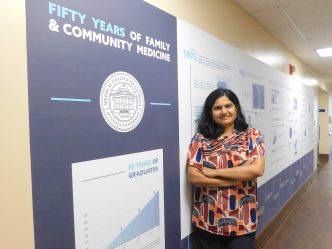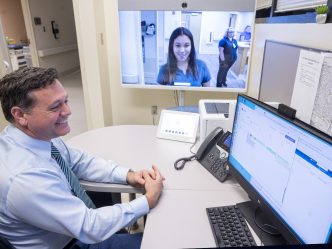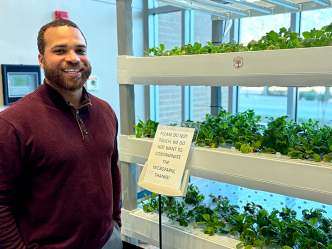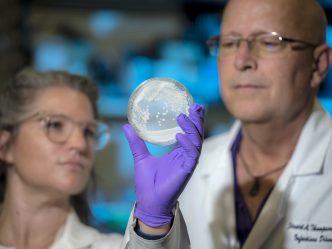Seventeen-year-old Rhett Jolly knows all about food.
With so many options to choose from, most people spend the better half of their day deciding where and what to eat, but not so for the third of Joel and Susan Jolly’s five boys. Rhett knows exactly what he will have.
“I can have the grilled nuggets at Chick-fil-A and the fries. I can have a pizza at Your Pie and a pizza at Mellow Mushroom,” he says.
The competitive baseball player says his preoccupation with food started as a way to build muscle in high school but quickly turned to necessity after a family dinner left the high school sophomore struggling to swallow.
With a piece of meat lodged in his esophagus, Rhett remembers feeling panicked as his mouth started to fill with saliva. A few seconds later his chest began to tighten and tears came pouring down his face. Barely able to speak, he motioned to his mom and dad for help.
Rhett’s dad, Joel, immediately called his uncle, a retired physician, who told the Jollys to take Rhett to the emergency department. Desperate to find relief for their son, the family abandoned their Edgefield, South Carolina, home and headed to Children’s Hospital of Georgia, where, 30 minutes later, doctors were calling for a surgeon.
“We said a prayer before he went in,” says Susan. “In the busyness of our life, church is very important and important enough for us to know that God is No. 1.”
As Dr. Robyn Hatley, pediatric surgeon at Children’s and professor of medicine and pediatrics at the Medical College of Georgia, worked to free the piece of meat, he noticed something unusual. Rhett’s esophagus was too narrow, preventing food from safely passing from his mouth to his stomach, creating chronic inflammation and obstruction like what the teen was currently experiencing.
It was something Hatley had seen before in children with chronic inflammatory disease of the esophagus caused by food allergies, commonly diagnosed as eosinophilic esophagitis.
The first person to mention the name out load, Hatley told the Jollys they would need to see a pediatric gastroenterologist to confirm the diagnosis. Feeling a mix of relief that Rhett had safely made it out of surgery and anxiety about what this new mystery diagnosis could mean for their son’s future, the Jollys say they leaned on their faith and went searching for answers.
A life-changing diagnosis
Rhett Jolly was 15 when he first remembers having difficulty swallowing. “It’s a weird feeling,” he says. “I can’t really explain it. You never know how much saliva you have until you can’t swallow.”
Susan says with five active boys, she attributed it to her son being a teenager and eating his food too quickly. The night of Rhett’s surgery she realized it was more serious but says it wasn’t until their initial visit with Dr. Vita Goei, pediatric gastroenterologist and professor of medicine at MCG, that she fully understood what Rhett was experiencing.
For most people, white blood cells called eosinophils are an important part of the body’s immune system. They help fight parasites in the blood and intestine. But when eosinophils appear in large quantities, they can cause irritation and inflammation. In EoE, the eosinophils gather in the esophagus, causing nausea, regurgitation, vomiting, abdominal pain, acid reflux and other symptoms.
At their first appointment, Goei recommended an endoscopy, a diagnostic test where an endoscope is inserted into the mouth and the esophagus, where a small tissue sample is taken. Rhett’s test results came back positive for eosinophils.
With certain foods being the most common trigger to the allergic response produced by EoE, clinicians immediately removed the top eight allergens from Rhett’s diet, including milk and eggs.
As Rhett got older, food restrictions became more challenging — especially when traveling for baseball or when out with his friends.
Food allergies on the rise
Research from the U.S. Centers for Disease Control and Prevention shows that food allergies in children have increased approximately 50% between 1997 and 2011, now affecting 1 in 13 children in the United States. This translates to roughly two students in every classroom.
About 90% of allergic reactions come from eight foods alone: milk, eggs, peanuts, tree nuts, soy, wheat, fish and shellfish. In total, food allergies cause about 300,000 ambulatory-care visits a year, just among children under age 18.
Katy Slagle, nurse practitioner in the EoE clinic at Children’s where Rhett was treated, says there isn’t a clear answer to what’s contributing to the rise in cases of EoE, but suspects it is due to a combination of increased awareness of the disease and an increase in food allergies themselves, which are the driving cause of EoE. Slagle says when she started taking care of kids with EoE in 2006, she had two patients. Ten years later, and with a clinic devoted to the disease, she now cares for well over 100 patients.
“Even now, there are a lot of people, a lot of providers who aren’t familiar with it,” she says. “It’s a condition that, if you don’t know what you’re looking for, can be easily missed.”

Slagle says symptoms of EoE often mimic acid reflux, with some children and teenagers complaining about food coming back up the esophagus and into the mouth, vomiting and abdominal pain. In younger kids, it can cause failure to thrive where children don’t grow like they should.
“For about 50% of the kids we diagnosed with EoE, it is the first time they’ve been told that they have food allergies,” she says.
The other 50%, she says, have some history of food allergies or other allergic disorders including asthma and eczema.
Knowing what to look for takes a trained eye, and it can still be tricky, since 10% to 20% of children with EoE may not show visible changes in the esophagus.
“So you have to be doing biopsies, and you have to have a pathologist who knows what they are looking for in those biopsies,” she says.
Once the diagnosis is made, Slagle and team discuss EoE in detail with the family and talk about options for management. In most cases, she says they proceed with an elimination diet, like in Rhett’s case, where top food allergens are removed and, once the repeat endoscopy shows that the disease is better controlled, food trials are started, where one food is added back at a time, every two to three months. Slagle says it takes a lot of teamwork with the family, with extensive diet teaching and ongoing communication, but it can make a huge difference once problematic foods are identified and eliminated.
The Jollys say the trial and error associated with Rhett’s disease is often the most frustrating. After months of work to eliminate foods and substitute others, a failed test, or a biopsy showing increased levels of eosinophils, has been hard on their son and family.
“So it’s a year of doing this, you go get this result and then where do you go from there?” says Susan.
Rhett says while the 45-minute commute home following a failed test can feel even longer, he always feels encouraged and supported by the team at Children’s.
“They don’t ever really tell me what to do,” he says. But they are always there helping the family navigate a disease that requires almost constant thought and attention.
“And they stay on top of new websites, research and foods and everything,” Rhett says.
A new normal
After more than two years, Rhett and his family say they finally have a good handle on his disease thanks to the providers at Children’s. They study food labels and comb grocery store shelves. They ask questions at restaurants and don’t take any chances. Even trace amounts of the wrong foods can lead to a major setback with painful consequences.

The Jollys say the biggest change for them has been in the work associated with preparing for what most people consider to be the routine. Rhett travels for summer baseball across the country, when he spends weeks away from home. Joel says Susan stays up the night before he leaves preparing a cooler of food that takes up the entire back seat of an automobile.
When asked about the reaction from Rhett’s teammates at having to bring more than just his suitcase and baseball glove, Joel says no one ever complains or utters a harsh word. In fact, the Jollys say all they’ve ever experienced from Rhett’s coach and teammates is an outpouring of support for their son.
“The things may seem insignificant, but they are huge,” Joel says. “On his baseball team everyone knows Rhett has this condition and it is what it is. It’s a part of who he is.
“They had a cookout at the beginning of the baseball season where a parent brought a little grill and plain hamburger meat and made [Rhett’s] burger on the side. We’ve been touched by the support that our community and school has provided Rhett and for wanting him to feel included.”
As Rhett prepares to attend college this fall in Newberry, South Carolina, where he will play baseball on a scholarship, the Jollys want families of children with EoE to know their kids can live a normal life.
“They have limitations, but Rhett has never let that define him,” Joel says. “He is living proof that you can continue to lead a normal life and not let it restrict you.”
Joel says the college is making accommodations for Rhett and are working on a dietary plan to help their son.
Like most parents of college freshmen, they are nervous about Rhett being away from home for the first time and working to manage his disease but are confident that he has what it takes to be successful.
“That’s why we want to help people,” Joel says. “Rhett has been such a success that we want people to know their children can do it, too.”
The Jollys encourage parents struggling to make sense of an EoE diagnosis to email them.

 Augusta University
Augusta University




